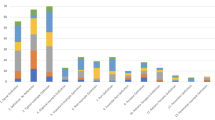Abstract
In a cross-border dimension considering the specific collaboration among European Union Member States related to criminal investigations and criminal trials, it becomes crucial to have a common and shared understanding of what Electronic Evidence is and how it should be treated in the EU context and in the EU MS. In this context the EVIDENCE project developed a tailor-made categorization of relevant concepts that allow to rely on a common and shared knowledge in this domain. The categorization provides a starting analysis for the exchange of Electronic Evidence and data between judicial actors and LEAs, with a specific focus on issues of the criminal field and criminal procedures. This semantic Structure might represent a good starting point for the alignment of electronic evidence concepts all over Europe in across border dimension. This categorisation is significant as it is one of the few initiatives to identify and classify relevant concepts in a domain, which currently lacks of clear boundaries and touches upon different disciplines.
Access this chapter
Tax calculation will be finalised at checkout
Purchases are for personal use only
Similar content being viewed by others
Notes
- 1.
European Informatics Data Exchange Framework for Court and Evidence, (funding scheme: CSA (Supporting Action), Call ID FP7-SEC-2013-1; grant agreement no: 608185; duration: 32 months (March 2014 – October 2016); coordinator: Consiglio Nazionale delle Ricerche (CNR-ITTIG), Italy; EU funding: Euro 1,924,589.00); http://www.evidenceproject.eu.
- 2.
European Convention on Mutual Assistance in Criminal Matters, Strasbourg, 20/04/1959, ETS No. 030; Council of Europe Convention on Laundering, Search, Seizure and Confiscation of the Proceeds from Crime, Strasbourg, 08/11/1990, ETS No. 141; Council of Europe Convention on the Transfer of Sentenced Persons, Strasbourg, 21 March 1983, ETS No. 112; Mutual assistance in criminal matters between Member States, Council Act of 29 May 2000 establishing in accordance with Article 34 of the Treaty on European Union the Convention on Mutual Assistance in Criminal Matters between the Member States of the European Union, 2000/C 197/01, OJ C 197, 12.7.2000; Second Additional Protocol to the European Convention on Mutual Assistance in Criminal Matters, Strasbourg, 8 November 2001, CETS No. 182; Council of Europe Convention on Cybercrime, Budapest, 23 November 2001, ETS 185.
- 3.
Directive 2014/41/EU.
- 4.
Explanatory Report to the Convention on Cybercrime.
- 5.
Council Act of 29 May 2000.
- 6.
Council Framework Decision 2008/978/EU.
- 7.
Directive 2013/40/EU.
- 8.
Directive 2014/41/EU.
- 9.
See EVIDENCE Deliverable 3.1 - Overview of existing legal framework in the EU Member States: http://s.evidenceproject.eu/p/e/v/evidence-ga-608185-d3-1-411.pdf and EVIDENCE Deliverable 3.2 - Status quo assessment and analysis of primary challenges and shortcomings: http://s.evidenceproject.eu/p/e/v/evidence-ga-608185-d3-2-412.pdf.
- 10.
Copyright note: documents included in the corpus have been downloaded using (a) biblioproxy.cnr.it, the internal web platform of Italian National Research Council to access commercial bibliographic resources, (b) downloaded from the Web if freely accessible. Please note that the full text collected during the categorization building-up activities had only research purposes and excluded any commercial use of resources.
- 11.
- 12.
A lemma is a canonical form of the word that may appear in several inflected forms. For example, in English, the verb ‘to investigate’ may appear as ‘investigate’, ‘investigated’, ‘investigates’, ‘investigating’. The base form, ‘investigate’, that one might look up in a dictionary, is called the lemma for the word.
- 13.
SKOS Simple Knowledge Organization System Primer, W3C Working Group Note 18 August 2009, http://www.w3.org/TR/skos-primer.
- 14.
- 15.
- 16.
References
Association of Chief Police Officers UK. Good Practice Guide for Digital Evidence (2012). http://www.digital-detective.net/digital-forensics-documents/ACPO_Good_Practice_Guide_for_Digital_Evidence_v5.pdf
Casey, E.: Digital Evidence and Computer Crime. Forensic Science, Computers, and the Internet, vol. XXVII, 3rd edn, p. 807. Elsevier, Amsterdam (2011). ISBN 9780123742681
Murphy, C.C.: The European evidence warrant: mutual recognition. In: Eckes, C., Konstadinides, T. (eds.) Crime Within the Area of Freedom Security and Justice: A European Public Order. Cambridge University Press, Cambridge (2011)
ĆosiĆ, J., ĆosiĆ, Z.: An ontological approach to study and manage digital chain of custody of digital evidence. J. Inf. Organ. Sci. 35(1), 1–13 (2011)
ĆosiĆ, J., ĆosiĆ, Z.: The necessity of develo** a digital evidence ontology. In: Proceedings of the 23rd Central European Conference on Information and Intelligent Systems, pp. 325–230. University of Zagreb (2012)
Council of Europe: Electronic Evidence Guide. A basic guide for police officers, prosecutors and judges (2014)
ISO/IEC 27037: Guidelines for identification, collection, acquisition, and preservation of digital evidence (2012)
Mason, S.: Electronic Evidence, p. 934. LexisNexis-Butterworths, London (2012). ISBN 9781405779876
Park, H., Cho, S.H., Kwon, H.-C.: Cyber forensics ontology for cyber criminal investigation. In: Sorell, M. (ed.) e-Forensics 2009. LNICST, vol. 8, pp. 160–165. Springer, Heidelberg (2009). https://doi.org/10.1007/978-3-642-02312-5_18
Schafer, B., Mason, S.: The characteristics of digital evidence. In: Mason, S. (ed.) Electronic Evidence, p. 25. LexisNexis Butterworths, London (2012)
SWGDE: Digital evidence: standards and principles, forensic science communications, vol. 2, no. 2, p. 2 (2000). www.swgde.org
Talib, A.M., Alomary, F.O.: Toward a comprehensive ontology based-investigation for digital forensics cybercrime. Int. J. Commun. Antenna Propag. 5(5), 263–268 (2015)
Author information
Authors and Affiliations
Corresponding author
Editor information
Editors and Affiliations
Rights and permissions
Copyright information
© 2018 Springer Nature Switzerland AG
About this paper
Cite this paper
Biasiotti, M.A., Conti, S., Turchi, F. (2018). Electronic Evidence Semantic Structure: Exchanging Evidence Across Europe in a Coherent and Consistent Way. In: Pagallo, U., Palmirani, M., Casanovas, P., Sartor, G., Villata, S. (eds) AI Approaches to the Complexity of Legal Systems. AICOL AICOL AICOL AICOL AICOL 2015 2016 2016 2017 2017. Lecture Notes in Computer Science(), vol 10791. Springer, Cham. https://doi.org/10.1007/978-3-030-00178-0_38
Download citation
DOI: https://doi.org/10.1007/978-3-030-00178-0_38
Published:
Publisher Name: Springer, Cham
Print ISBN: 978-3-030-00177-3
Online ISBN: 978-3-030-00178-0
eBook Packages: Computer ScienceComputer Science (R0)



